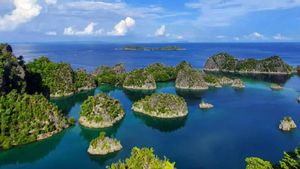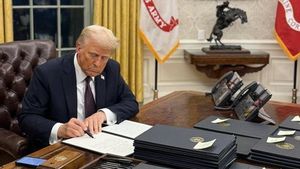JAKARTA - China on Thursday April 29 launched its first permanent space station main module that will accommodate astronauts in the long term.
The latest success for the space program has recently become China's ambition, with continued development and launching.
The Tianhe Module, or Heavenly Harmony, glides into space aboard a Long March 5B rocket from the Wenchang Launch Center in the southern island province of Hainan, marking another major advance for China's space exploration program.
According to the Korea Times, the launch began the first of the 11 missions required to build and provide a space station. As well, sending a crew of three at the end of next year.
China's Chang'e 5 space program also recently brought back samples from the Moon for the first time in more than 40 years. And, China also hopes to land probes and explorers on the surface of Mars by the end of the month through the Tianwen-1 mission.

Minutes after launch, the fairing opened to expose Tianhe on the rocket core stage, with the Chinese Manned Space characters emblazoned on the outside. Soon after, it escapes from the rocket, which will orbit about a week before crashing to Earth.
The space program is a source of great national pride. Prime Minister Li Keqiang as well as other civilian and military leaders witnessed the live launch from the control center in Beijing.
The core module is the part of the station where astronauts will live for up to six months at a time. The remaining 10 launches will deliver two more modules in which the crew will conduct experiments, four cargo supply deliveries and four crew missions.
At least 12 astronauts are training to fly to and live at the station, including former aviation veterans, newcomers and women, with the first crew mission, Shenzhou-12, expected to launch in June.

When completed in late 2022, China's t-shaped Space Station is expected to weigh about 66 tonnes, considerably less than the International Space Station (ISS), which launched its first module in 1998 and weighed about 450 tonnes when completed.
Tianhe will have a docking port and will also be able to connect with powerful Chinese space satellites. Theoretically, this can be extended to six modules. This station is designed to operate for at least 10 years.
Tianhe is the size of the American Skylab space station in the 1970s and the former Soviet / Russian Mir, which operated for more than 14 years after being launched in 1986.
The core module will provide living space for six astronauts during crew changes, while the other two modules, Wentian, or Quest for the Heavens and Mengtian or Dreaming of the Heavens, will provide space for conducting scientific experiments including those in medicine and the properties of the external environment. space.
To note, China started working on the space station project in 1992, just when its space ambitions took concrete shape. The need to do it yourself became even more urgent, after being removed from the ISS.

Yes, as reported by Fox News and Nationalinterest, China was 'expelled' from the ISS because of the use of anti-satellite weapons and hacking of the jet propulsion laboratory's intellectual property. This triggered the passage of a United States bill banning China from the ISS in 2011.
After years of successful launching of commercial rockets and satellites, China put its first astronaut into space in October 2003, becoming the third country to do so independently after Russia and the United States.
Alongside more crew missions, China launched a pair of experimental single-module space stations - Tiangong-1, meaning Heavenly Palace-1 and its successor, Tiangong-2. The first caught fire after contact was lost and its orbit decomposed, while the second was successfully ejected from orbit in 2018.
Enough? Not yet. In 2024, China plans a mission to bring back samples of the Moon, as well as land people and possibly build a scientific base there. And, to support it, a top secret spacecraft is said to be under development.
The English, Chinese, Japanese, Arabic, and French versions are automatically generated by the AI. So there may still be inaccuracies in translating, please always see Indonesian as our main language. (system supported by DigitalSiber.id)













